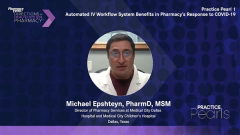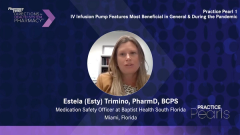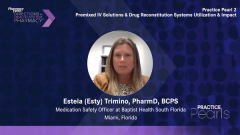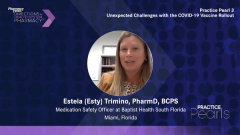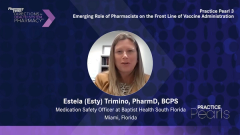
Practice Pearl 2: Infection Control Challenges Due to COVID-19—PPE
Michael Epshteyn, PharmD, MSM, discusses some of the infection control challenges caused by COVID-19, such as the procurement of personal protective equipment (PPE).
Episodes in this series

Madeline Camejo, PharmD, MS: One example of a challenge during COVID-19 was that lot of medications get returned to pharmacy, and we were trying to deal with infection control issues of these COVID-19 floors, where you had to wipe down, sequester medications, and were not able to put them into inventory. It was a constant, challenging time, for pharmacy. Michael, that was going to be a question for you, then Esty, you can answer the same question. What were some of the other challenges pertaining to infection control caused by COVID-19? For example, PPE [personal protective equipment] policies and procedures that we had to change and do on the fly, the long tubing that Esty talked about. What were some of the things at [Medical City Dallas Hospital] that you all had to do?
Michael Epshteyn, PharmD, MSM:There were similar challenges. I would say we were fortunate, we have always had enough PPE. But we implemented more monitoring and rationing. One example would be, we’re a high-volume oncology hospital, and we make 50 to 70 chemotherapy preparations a day. Chemotherapy gowns, at one point, went into shortage because when the regular gowns weren’t available, all of a sudden everybody started buying chemotherapy gowns, even though they didn’t really need the protection. As a result, we had a hard time procuring enough chemotherapy gowns. So we took that over from the supply chain, and pharmacy would supply gowns for a nurse to use with every chemotherapy medication we delivered. That way we were assured that the nurse had a chemotherapy gown to protect themselves while administering chemotherapy, and we prevented someone from taking those precious gowns and using them for some other reason.
Those are some of the creative ways where pharmacy took on more work and initiative to help with appropriate distribution and conservation of PPE. That one stands out to me; we never saw ourselves as distributors of gloves and gowns and other PPE. But sometimes we had to step it up and take that additional responsibility so that we were very rational and regimented in our approach to make sure that those employees who needed appropriate PPE had it available to them and that it wasn’t used inappropriately, therefore, depriving others from it.
We’ve done a good job and adjusted quickly because we could always tell what the inventory stock levels were so we could ration what we needed, and it worked out well. And of course, we had to reach out to and find new suppliers of these products because we couldn’t get enough through our regular channels.
Transcript edited for clarity.
Newsletter
Stay informed on drug updates, treatment guidelines, and pharmacy practice trends—subscribe to Pharmacy Times for weekly clinical insights.

